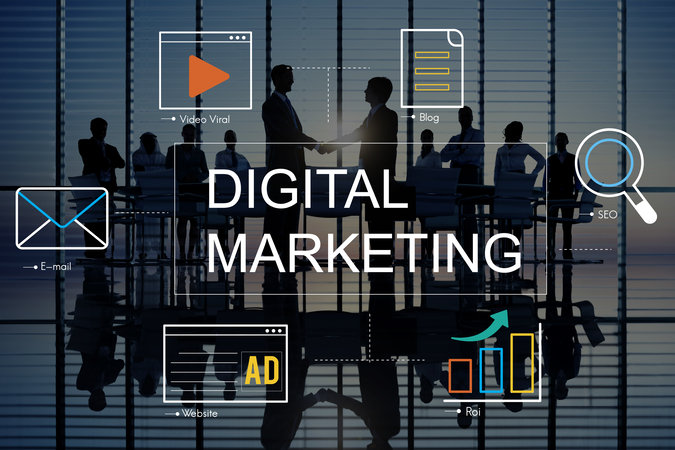Success in digital marketing doesn’t happen overnight. It’s an ongoing process of learning, changing, and getting better. Now that the internet and smartphones are more popular, people are more linked than ever. To stay competitive, small businesses need to use digital marketing services. This blog will explore the importance of digital marketing for small businesses, key strategies, and the top service providers in the industry.
Introduction to Digital Marketing for Small Businesses
In the present-day environment, small businesses need to have a strong online footprint. Digital marketing services for small businesses play a crucial role in achieving this. Digital marketing includes a lot of different methods used to promote goods and services through different online platforms. Some of these are search engines, social networks, email marketing, and more. Digital marketing isn’t just a trend for small businesses; they need to do it to keep growing.
Key Components of Digital Marketing Services for Small Businesses
1. Search Engine Optimization (SEO)

Improve your website’s visibility in search engine results like Google and Bing when people look for goods, services, or information related to your website. This is called search engine optimization (SEO). Several methods are used to achieve this, such as optimizing the text, structure, and meta-tags of a website. SEO is important for small businesses because it can help them be seen online, build trust, and get the right people to visit their websites. It’s an affordable technique to sell your business that works in the long run.
2. Social Media Marketing

With billions of people utilizing social media platforms like Facebook, Instagram, Twitter, and LinkedIn, social media marketing is a powerful tool that small businesses can use to connect with the audience they want to reach. Regularly posting, sharing material that is fascinating, and making use of targeted advertisements are all ways to significantly boost the degree to which people recognise the brand and connect with it.
As an illustration, a small business that specializes in the production of handcrafted jewelry utilizes Instagram as a platform to showcase their wares, offer behind-the-scenes photographs, and promote their products to a more extensive audience through sponsored posts.
3. Content marketing

For digital marketing to work, you need to make content that is useful and important. Content marketing helps establish your business as an authority in your industry and contributes to your SEO efforts. High-quality content can increase engagement with your target audience, leading to increased brand awareness, more leads, and sales. It can also build credibility and attract the right audience to your website. By sharing informative and valuable content with your target audience, you can build trust and credibility, which can help improve your brand’s reputation. Making quality content is important if you want your business to be seen as an expert in its field. By using specific words on your website and making sure it’s set up in a way that search engines like, you can increase your online visibility. Tools like Moz and SEMrush can help track how well this is working and suggest ways to make it better.
4. Email Marketing

Email marketing is a cost-effective means for small companies to get in touch with their customers. It involves sending newsletters, promotional emails, and personalized content to nurture leads, retain customers, and drive sales. Email marketing can help build strong customer relationships, increase brand awareness, and boost sales. There are many types of marketing emails, including welcome emails, newsletters, lead nurturing emails, promotional emails, and transactional emails. By utilizing email marketing, small businesses can reach new customers, nurture leads, and close sales.
Here are some of the best practices for creating effective email marketing campaigns:
Write captivating copy: Create engaging and relevant content for your emails to capture the recipients’ attention.
Avoid sending campaigns to a stale list. Regularly clean your contact list to maintain high open rates and avoid being marked as spam.
Only send email campaigns with permission. Before you send business emails to people, make sure you have their consent.
Segment your audience: Divide your email list into segments based on various factors such as demographics, behavior, or interests to send more targeted and relevant content.
Make it personal: Personalize your emails to make them more relevant and engaging for the recipients.
Include a clear call to action (CTA): Clearly state what you want the recipients to do next, such as making a purchase or visiting a website.
Follow up: Send follow-up emails to remind recipients of your previous email and encourage them to take action.
Use an email marketing platform: Utilize an email marketing platform to manage your campaigns and contacts and track key metrics like email opens and bounce rates.
Test your emails and adjust accordingly. Conduct A/B testing to optimize your email content and design for better performance.
By following these best practices, you can create more effective and engaging email marketing campaigns to reach and connect with your target audience.
5. Pay-Per-Click (PPC) Advertising

PPC advertising, or pay-per-click, is a cost-effective and direct way for small businesses to communicate with their audience. By bidding on keywords and placing ads in search engine results, businesses can increase their visibility and attract potential customers. Google Ads is a popular platform for small businesses to kickstart their PPC campaigns.
If you want to make good PPC ads, think about these best practices:
Set clear goals: Determine what you want your customers to do, such as calling you, visiting your store, or visiting your website. This will help you decide where to be seen across Google Search, YouTube, and the web.
Target specific keywords: Use long-tail and local keywords that are relevant to your business and target audience. This can help you reach a more specific audience and reduce competition.
Create targeted ad copy: Tailor your ad copy to match your target audience and the keywords they are searching for. This can increase the relevance of your ads and improve their performance.
Utilize ad extensions: Use ad extensions to provide additional information, such as your business address, phone number, or links to your website. This can increase the visibility of your ads and improve their click-through rate.
Monitor and adjust bids: Regularly review your campaign performance and adjust your bids accordingly. This can help you make your ads work better by optimizing them.
Test and optimize: Conduct A/B testing to optimize your ad content and design for better performance. This can help you identify the most effective strategies and improve your overall campaign results.
Understanding Your Digital Terrain
A very important first step before you start your digital journey is to get to know the area. To do this, you need to do a complete competitor analysis, which means looking closely at your competitors’ websites and figuring out what works and what doesn’t about them. Tools like Semrush and Moz can help people learn a lot about their website visitors, terms, and social media activity.
Digital Marketing Services for Small Businesses: How to Choose the Right Provider
- Maple Service Solution: Maple Service Solution is a digital marketing company that offers a range of services, including SEO, PPC, and social media marketing, to help small businesses grow their online presence and reach their target audience. Maple Service Solution stands out as a reliable and effective option for small businesses looking to improve their digital marketing efforts.
- SEMrush: From keyword research to competitor analysis and backlink audits, this Russian powerhouse equips you with SEO tools to dominate international search engine rankings.
- Zoho Social: With its social media management suite, scheduling posts, tracking engagement, and managing multiple accounts across borders becomes a breeze with Zoho Social, hailing from India.
- HubSpot: This Irish giant offers an all-in-one inbound marketing toolbox, from CRM and email marketing to social media management, all wrapped in a user-friendly interface—perfect for streamlining your global endeavors.
- Google Ads: For businesses looking to leverage PPC advertising, Google Ads remains a go-to platform. With its extensive reach and precise targeting options, small businesses can drive traffic to their websites and generate leads effectively.
Tracking Progress and Making Adjustments to Approaches
There is no silver bullet when it comes to digital marketing, and small businesses need to be sure they are measuring their results. It is important to keep an eye on key performance indicators (KPIs), including website traffic, conversion rates, and social media engagement, on a frequent basis. Digital marketing tactics can be fine-tuned and adjusted with the use of analytical tools such as social media insights and Google Analytics.Here’s a step-by-step guide to building your personalized digital marketing action plan:
Define your goals and KPIs: What do you want to achieve with your digital marketing efforts? Increase website traffic, generate leads, boost sales, or build brand awareness.
Set SMART goals: time-bound, relevant, realistic, doable, and specific. For example, aim to increase website traffic by 20% within the next quarter.
Identify key performance indicators (KPIs) to track your progress towards your goals. Website traffic, conversion rates, lead creation, and social media engagement are examples of common KPIs.
Craft Your Ideal Customer Profile: Next, map out your target audience. With your marketing message, who are you aiming to reach? Paint a detailed picture of your ideal customer, including demographics, interests, online behavior, and pain points.
Tools like Google Analytics and social media audience insights can provide valuable data to build your customer profile.
Develop Your Content Strategy: What kind of content will resonate with your target audience? Informative blog posts, engaging videos, witty social media posts, or customer testimonials?
Create a content calendar to plan your content creation and publishing schedule.
Ensure your content is high-quality, relevant, and optimized for search engines.
Choose Your Digital Marketing Channels: Based on your audience and goals, identify the most effective digital marketing channels for your business. This could include website optimization, SEO, social media marketing, email marketing, or PPC advertising.
Prioritize and allocate resources for each channel based on their potential impact and return on investment (ROI).
Implement Tracking and Measurement: Set up analytics tools like Google Analytics and social media platform insights to track your website traffic, engagement, and campaign performance.
Regularly analyze your data to understand what’s working and what’s not, and make data-driven adjustments to your strategy.
Continuous Optimization and Experimentation: The digital landscape is constantly evolving, so be prepared to adapt and experiment. Try new tools, test different content formats, and analyze the results to find what works best for your audience.
Stay informed about emerging trends, and don’t be afraid to pivot your strategy when new opportunities arise.
Real-World Examples: A local bakery increases website traffic and sales. A local bakery used Instagram to showcase its mouthwatering treats, ran targeted Facebook ads to attract customers within a specific radius, and offered exclusive online discounts to drive traffic to their website. This resulted in a 30% increase in website traffic and a 25% boost in online sales.
Remember, Rome Wasn't Built in a Day

Building a successful online presence takes time, dedication, and consistent effort. Don’t be discouraged by setbacks; view them as opportunities to learn and adapt.
Partnering with complementary businesses or agencies can amplify your reach, expertise, and ROI. Here are some powerful collaborative strategies to consider for small businesses:
Cross-promotion: Join forces with non-competing businesses that cater to a similar audience. Co-host webinars, exchange guest blog posts, or run joint social media campaigns to cross-promote each other’s offerings and expand your reach.
Influencer marketing: identify social media influencers in your niche who resonate with your brand and target audience. Partner with them to create product reviews, tutorials, or sponsored content that can tap into their established audience and inject trust into your brand.
Local partnerships: If your business has a physical location, leverage local partnerships with complementary businesses, community organizations, or event organizers. Cross-promote each other’s services, co-sponsor local events, or offer joint customer appreciation initiatives to strengthen your local presence and attract new customers.
Agency partnerships: For businesses lacking in-house digital marketing expertise, partnering with a reputable agency like Maple Service Solution can be a strategic move. Agencies offer professional guidance, access to specialized skills, and ongoing campaign management, allowing you to focus on core business operations while reaping the benefits of effective digital marketing.
Community engagement: Actively engage with online communities relevant to your industry or target audience. Participate in forums, contribute to discussions, and offer valuable insights. This positions you as a thought leader, builds brand awareness, and fosters trust with potential customers.
Leveraging technology: Embrace automation tools and collaboration platforms like Slack, Asana, and Trello to streamline communication, project management, and content creation within your team or with any external partners. This ensures smooth collaboration, improves efficiency, and keeps everyone on the same page.
Successful collaboration hinges on shared values, clear communication, and mutually beneficial goals. Choose partners who complement your brand and expertise, openly communicate expectations, and celebrate shared successes.
The Future of Digital Marketing Services for Small Business: Navigating New Horizons
Since the digital world is always changing, being ahead of the curve is essential for long-term success. The following are some trends to watch:
Artificial intelligence (AI): AI-powered tools are becoming increasingly sophisticated, aiding in content creation, ad targeting, and personalized customer experiences. As AI capabilities mature, expect to see even greater integration into small business marketing strategies.
Voice search: With the rise of smart speakers and virtual assistants, voice search is transforming how users interact with the internet. Optimize your website content and online presence for voice queries to ensure discoverability in this growing trend.
Personalization: Businesses are reacting to consumer demand for personalized experiences with AI-powered chatbots, dynamic content, and targeted advertising. Invest in technologies that let you customize your marketing campaigns to the unique tastes and habits of each client.
Social commerce: combining e-commerce and social media is becoming more popular, letting people buy things right from their favorite social media sites. You can use the power of influencer marketing to boost sales and change your social media plan to include shoppable features.
Sustainability and ethical marketing: Consumers are increasingly conscious of the environmental and social impact of the brands they support. Embrace sustainable practices, promote ethical sourcing, and be transparent about your values to resonate with this growing consumer demographic.
Remember, The future of digital marketing is about flexibility, adaptability, and embracing new technologies. Stay informed about emerging trends, experiment with innovative strategies, and don’t be afraid to pivot when necessary.
Small Business and the Power of Digital Marketing


World wide web? A huge area for small businesses to play! Learn how to do things like make cool content and make people feel welcome in your digital marketing. Get to know your customers, follow trends like a wave, and be ready to change quickly.
This blog post gave an in-depth look at the most important digital marketing services for small businesses, including techniques that can be used right away, real-life examples, and predictions about what will be popular in the future. Your small business can easily claim its rightful place in the online world and achieve long-term success by using these tips and staying up-to-date on how the digital world is changing.









